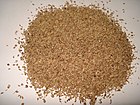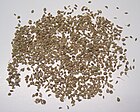Note: This is a project under development. The articles on this wiki are just being initiated and broadly incomplete. You can Help creating new pages.
Difference between revisions of "Trachyspermum ammi - Carom, Ajwain, Ajamoda"
| Line 8: | Line 8: | ||
==Uses== | ==Uses== | ||
| − | {{Uses| | + | {{Uses|Stomachache}}, {{Uses|cold}}, {{Uses|Asthma}}, {{Uses|Diabetes Mellitus}}, {{Uses|Cholera}}, {{Uses| Kidney Stone}}, {{Uses|Weight Loss}}, {{Uses|Gas and Flatulence}}, {{Uses|Acidity and Hyperacidity}}, {{Uses|Culinary Recipes}}, {{Uses|indigestion}}. |
==Parts Used== | ==Parts Used== | ||
| Line 17: | Line 17: | ||
==Common names== | ==Common names== | ||
| − | {{Common names|kn=|ml=|sa=|ta=|te=|hi=|en= | + | {{Common names|kn=Ajamoola, oma|ml=|sa=Ajamoda|ta=Omam|te=omaan, vamu|hi=Ajwain|en=Ajwain}} |
==Properties== | ==Properties== | ||
| Line 40: | Line 40: | ||
==Identification== | ==Identification== | ||
===Leaf=== | ===Leaf=== | ||
| − | {{Leaf|Simple||The leaves are | + | {{Leaf|Simple||The leaves are rather distant, 2-3-pinnately divided in narrow linear segments}}<ref name="Leaf"/> |
===Flower=== | ===Flower=== | ||
| − | {{Flower|Unisexual|2-4cm long| | + | {{Flower|Unisexual|2-4cm long|white and small|5-20|Flowers are borne in terminal or seemingly-lateral stalked}} |
===Fruit=== | ===Fruit=== | ||
| − | {{Fruit||7–10 mm | + | {{Fruit|ovoid|7–10 mm|The fruits are ovoid, aromatic, greyish brown|The mericarps, which are the components of the fruit, are compressed|many}} |
| − | + | ||
===Other features=== | ===Other features=== | ||
| Line 65: | Line 65: | ||
==Photo Gallery== | ==Photo Gallery== | ||
<gallery class="left" caption="" widths="140px" heights="140px"> | <gallery class="left" caption="" widths="140px" heights="140px"> | ||
| − | + | Ajowan.jpg | |
| − | + | ||
| − | + | Ajwain.JPG | |
| + | |||
| + | |||
| + | Ayamodakam-003.jpg | ||
| + | |||
| + | |||
| + | Ayamodakam-ajwan-002.jpg | ||
| + | |||
| + | |||
| + | Carom Flowers.jpg | ||
| + | Carom Flowers.jpg | ||
| + | Carom.jpg | ||
| + | Carom.jpg | ||
</gallery> | </gallery> | ||
| Line 75: | Line 87: | ||
<ref name="chemical composition">[http://gernot-katzers-spice-pages.com/engl/Trac_cop.html "chemical constituents"]</ref> | <ref name="chemical composition">[http://gernot-katzers-spice-pages.com/engl/Trac_cop.html "chemical constituents"]</ref> | ||
| − | <ref name="Leaf">[https:// | + | <ref name="Leaf">[https://www.flowersofindia.net/catalog/slides/Ajwain.html "plant description"]</ref> |
<ref name="How to plant/cultivate">[https://www.pfaf.org/user/Plant.aspx?LatinName=Trachyspermum+ammi "Cultivation details"]</ref> | <ref name="How to plant/cultivate">[https://www.pfaf.org/user/Plant.aspx?LatinName=Trachyspermum+ammi "Cultivation details"]</ref> | ||
Revision as of 17:31, 11 June 2018
Trachyspermum ammi is an annual herb in the family Apiaceae. It originated in India and Pakistan. Both the leaves and the fruit of the plant are consumed by humans.
Contents
- 1 Uses
- 2 Parts Used
- 3 Chemical Composition
- 4 Common names
- 5 Properties
- 6 Habit
- 7 Identification
- 8 List of Ayurvedic medicine in which the herb is used
- 9 Where to get the saplings
- 10 Mode of Propagation
- 11 How to plant/cultivate
- 12 Commonly seen growing in areas
- 13 Photo Gallery
- 14 References
- 15 External Links
Uses
Stomachache, cold, Asthma, Diabetes Mellitus, Cholera, Kidney Stone, Weight Loss, Gas and Flatulence, Acidity and Hyperacidity, Culinary Recipes, indigestion.
Parts Used
Lovage seed, Caraway-like fruits.
Chemical Composition
The essential oil (2.5 to 5% in the dried fruits) is dominated by thymol (2-isopropyl-5-methylphenol, 35 to 60%); furthermore, α-pinene, p-cymene, limonene and γ-terpinene have been found[1]
Common names
| Language | Common name |
|---|---|
| Kannada | Ajamoola, oma |
| Hindi | Ajwain |
| Malayalam | |
| Tamil | Omam |
| Telugu | omaan, vamu |
| Marathi | NA |
| Gujarathi | NA |
| Punjabi | NA |
| Kashmiri | NA |
| Sanskrit | Ajamoda |
| English | Ajwain |
Properties
Reference: Dravya - Substance, Rasa - Taste, Guna - Qualities, Veerya - Potency, Vipaka - Post-digesion effect, Karma - Pharmacological activity, Prabhava - Therepeutics.
Dravya
Rasa
Tikta (Bitter), Kashaya (Astringent)
Guna
Laghu (Light), Ruksha (Dry), Tikshna (Sharp)
Veerya
Ushna (Hot)
Vipaka
Katu (Pungent)
Karma
Kapha, Vata
Prabhava
Habit
Identification
Leaf
| Kind | Shape | Feature |
|---|---|---|
| Simple | The leaves are rather distant, 2-3-pinnately divided in narrow linear segments |
Flower
| Type | Size | Color and composition | Stamen | More information |
|---|---|---|---|---|
| Unisexual | 2-4cm long | white and small | 5-20 | Flowers are borne in terminal or seemingly-lateral stalked |
Fruit
| Type | Size | Mass | Appearance | Seeds | More information |
|---|---|---|---|---|---|
| ovoid | 7–10 mm | The fruits are ovoid, aromatic, greyish brown | The mericarps, which are the components of the fruit, are compressed | many | {{{6}}} |
Other features
List of Ayurvedic medicine in which the herb is used
- Vishatinduka Taila as root juice extract
Where to get the saplings
Mode of Propagation
How to plant/cultivate
Requires a moist soil in a sunny position. This species is not frost tolerant[238], but it might be possible to grow it outdoors in Britain as a spring sown annual[3]
Commonly seen growing in areas
Damp ground, meadows, Borders of forests and fields.
Photo Gallery
References
External Links
- Ayurvedic Herbs known to be helpful to treat Stomachache
- Ayurvedic Herbs known to be helpful to treat cold
- Ayurvedic Herbs known to be helpful to treat Asthma
- Ayurvedic Herbs known to be helpful to treat Diabetes Mellitus
- Ayurvedic Herbs known to be helpful to treat Cholera
- Ayurvedic Herbs known to be helpful to treat Kidney Stone
- Ayurvedic Herbs known to be helpful to treat Weight Loss
- Ayurvedic Herbs known to be helpful to treat Gas and Flatulence
- Ayurvedic Herbs known to be helpful to treat Acidity and Hyperacidity
- Ayurvedic Herbs known to be helpful to treat Culinary Recipes
- Ayurvedic Herbs known to be helpful to treat indigestion
- Herbs with Lovage seed used in medicine
- Herbs with Caraway-like fruits used in medicine
- Herbs with common name in Kannada
- Herbs with common name in Hindi
- Herbs with common name in Tamil
- Herbs with common name in Telugu
- Herbs with common name in Sanskrit
- Herbs with common name in English
- Habit - Herb
- Index of Plants which can be propagated by Seeds
- Index of Plants which can be propagated by Cuttings
- Herbs that are commonly seen in the region of Damp ground
- Herbs that are commonly seen in the region of meadows
- Herbs that are commonly seen in the region of Borders of forests and fields
- Herbs







